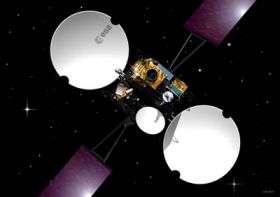Artemis provides communications for Jules Verne ATV

ESA's Artemis data relay satellite, controlled from Fucino (Italy) and with its mission control centre and Earth terminal located at Redu (Belgium), is providing communications between the Jules Verne ATV and the ATV Control Centre in Toulouse (France).
Jules Verne ATV was launched from Europe's Spaceport in French Guiana at 05:03 CET on 9 March. First contact between Artemis and the ATV was established at 06:46, exactly on schedule.
Artemis communicates with Jules Verne, receiving telemetry and sending telecommands, each time the two spacecraft are within sight of one another. During every ATV orbit, there is around 40 minutes of continuous contact. Artemis will provide dedicated support to Jules Verne throughout the free-flying phase of its mission - up to the docking planned for 3 April. After docking, Artemis' data relay resource will be shared between ATV and ESA's Envisat Earth observation mission.
Artemis is in geostationary orbit over the Atlantic Ocean. It has three main purposes:
-- the provision of voice and data communications between mobile terminals in remote areas of Europe and North Africa, as well as in the Atlantic
-- performing a key role within Europe's EGNOS satellite navigation system by broadcasting enhanced GPS and GLONASS signals for use by civilian 'safety critical' transport and navigational services
-- the provision of inter-orbit satellite communication using advanced S- and Ka-band radio links and laser technology
Artemis is operated from ESA's facility at Redu, which houses the spacecraft's mission control centre and a Ka-band ground terminal with a 13.5-metre dish antenna.
The task of communicating with Jules Verne is shared between Artemis and NASA's Tracking and Data Relay Satellite System (TDRSS).
The inter-orbit communications services provided by Artemis are precursors to a proposed future European satellite data relay system.
Source: European Space Agency



















